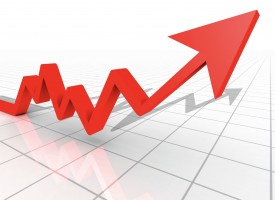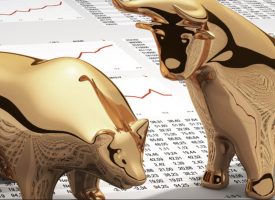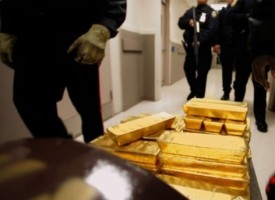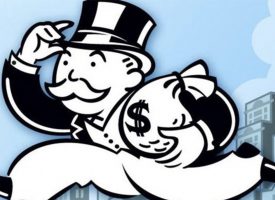It appears that gold and silver are back in fashion.
February 14 (King World News) – John Ing: The US Federal Reserve’s spending increased 54%, reminiscent of the 1970s when inflation took off as easy money led to increased leverage and inflated stock prices. Policymakers then as now believed the upsurge was temporary. President Gerald Ford too blamed Wall Street, issued WIN (Whip Inflation Now) buttons and imposed draconian price controls. Mr. Biden also believes that inflation is temporary but persists in stoking the inflationary fires, spending unprecedented sums to keep the economy from free-falling during Covid. The parallels do not stop there. Like the seventies, energy prices have skyrocketed but not because of OPEC but because of Mr. Biden’s regulatory heavy hand which has blocked exploration, development and even the construction of pipelines, which resulted in shortages, elevated demand and much higher energy prices. Some things stay the same. As before Mr. Biden blamed everyone including OPEC, corporate America, the food cartels and even Big Oil. Oil prices now seem headed for US 100 bbl. And yet Mr. Biden’s solution is to spend more money to end inflation. The consequence of all this is higher debt than before, higher prices, and bigger government.
…Shortages and high energy prices will persist making inflation worse this time as climate obsession and the winds blow through global capital markets driving lending and investment out of fossil fuels and into renewables in the effort to wean the world from fossil fuels. True, fossil fuel is a factor in global warming but not the factor or only factor. Investment in fossil fuels as a result has fallen sharply but consumer demand hasn’t. Consequently, energy prices are skyhigh as renewables have been found to be unreliable. Natural gas prices are up 850%. Consumers are bearing the brunt, paying higher energy bills and higher taxes. Government policies to incentivize electric vehicles (EVs) also boosted demand for critical supplies of lithium, copper, and nickel needed to make the batteries, putting energy transition at risk. Inflation also hit the general car industry which has become like fossil fuels, the lightning rod for climate change. In addition, resilient consumer demand and chip shortages caused used car prices to jump a whopping 45% last year. While billions of subsidies and incentives are spent, it does not match the reality that transportation only makes up 11% of global emissions. The reality today is that despite billions spent on subsidies and new technology, electric vehicles make up a paltry 8.6% of the new car market. So much money, too few results.
The Fed Is Part of The Problem
The government has pumped massive amounts of money into the economy to combat the pandemic recession. At the same time the Fed also pledged to keep monetary policy expansionary until full unemployment was reached. What is full unemployment? Labour markets are tight. Employers added almost 500,000 jobs, despite millions out sick. A host of data shows that labour markets are already behaving in late-cycle fashion with sharp drops in unemployment and a huge number of unfilled jobs. Besides, millions aren’t working either to care for someone or are sick themselves. Also with high quit rates and as much as 20% of American income coming from government benefits (ZIRP, PPP, CTC), subsidised workers stayed home. A decline in immigrants, legal or otherwise compounded the problem. Of concern is that at 4% we are at or near what was once considered full unemployment, a level reached in the Great Inflation period of the late 1960s and 1970s. The Fed’s inaction is noteworthy allowing Mr. Biden to pile on the stimulus, encouraging consumers to spend more on imported goods while exports lag, resulting in a trillion-dollar trade deficit for the first time ever. Why this matters is that to finance the deficit, the Fed’s balance sheet has grown 10 times larger than the 2008 financial crisis and much of America’s debt to pay for that surge in consumer spending is owed to foreigners. The only thing transitory is the Fed’s usage of that word.
In addition, the rip-roaring bull market fueled by the Fed’s money printing has created more rich multi-billionaires and trillion-dollar corporations (Apple’s market cap is $3 trillion) than ever. Government today is bigger not smaller. Booming asset prices has benefited the rich who now occupy government. It does not help that some of the most powerful lawmakers on Capitol Hill recently resigned over possible conflicts of interest, trading while in possession of material non- public information, despite their conflicted position. As for the so-called independent Fed, a trading scandal had three of its senior officials resign, tarnishing the Fed’s independent reputation, resulting in an overdue review of trading – but after the horse left the barn…
To find out which silver company just made a major acquisition that will
quadruple their production click here or on the image below

Self-Inflicted Vulnerabilities
The pickup in geopolitical tensions, climate change and the self-inflicted energy vulnerability of the West has undermined America’s hegemony. Moreover Biden’s retreat from globalisation has resulted in spiralling energy prices, hurting American consumers in the pocketbook. Similarly, Europe too is vulnerable and because of their heavy reliance on Russian natural gas, face much higher gas prices on top of soaring bills particularly if Russia squeezes supplies in response to Western sanctions. The run-up in energy prices helped make Russia the largest gas producer in the world. The approval of the recently completed $11 billion Nord 2 Stream gas pipeline is an ideal bargaining chip since Europe relies on Russia for 40% of their gas imports. Then there is Germany which ironically shutdown their nuclear reactors, making them more reliant on Russian gas, potentially splitting the Western alliance’s unity. While nuclear has a 25% share in the US, there is no uranium production currently in the US and thus they are dependant on uranium imported from the former Soviet Union, including Russia and Kazakhstan.
Debt Pandemic
Moreover there is the alternate reality of the Federal Reserve, rather than a steward of money became a creator of money, aiding and abetting government’s spendthrift ways. Fed Chair Powell earlier said the surge in CPI inflation at 7.5%, the largest jump in 40 years was transitory and not of the Fed’s doing, but more of a supply/demand mismatch caused by the pandemic. Mr. Powell now believes differently, showing naïve ignorance in the consequences of the Fed’s unprecedented programme of reducing rates to near zero and monthly purchases of $120 billion of government debt would lead to higher inflation. The good news is that the Fed finally recognizes the inflation problem.
The bad news is that Fed policy is still stimulative and on track to remain so, while the supply of government bonds keeps expanding to fund the mountain of debt. US money supply rose 8% in January. The Fed is part of the inflation problem. We believe years of quantitative easing and MMT was the major factor in causing inflation to run at the fastest pace since the seventies, exacerbated by the pandemic stimulus. Ultra-cheap money encouraged homeowners to buy big homes with big mortgages, businesses to buy each other at inflated prices and a global stock market boom. The reality though is that America’s financial prolificacy which has led to a mountain of debt, makes America more dependent on others like China. America’s push for self-sufficiency is illusory, a policy by pretension. There is no alternate reality here.
History shows that when debt gets unmanageable, governments try to inflate their way out of debt as the most expedient method to pay down that debt. However the cost outweighs the benefits. Turkey is a good example. Today stocks are in the biggest bubble ever and inflation is deep rooted. Stocks are more leveraged, concentrated and risk is skyhigh. With liquidity at new records and investors buying the dips, a melt-up rather than a meltdown is likely. However the Fed is using “hawkish” threats but is “running” out of tools and reluctant to trigger a recession to stop inflation. Inflation is dynamic and WIN buttons or “tough” rhetoric did not work in the seventies when they lost control as inflation jumped to double digits. Then former Fed Chair Paul Volcker was forced to hike interest rates to double digit levels that curbed spending and led to two recessions just to get inflation under control. If Mr. Powell continues this path, hyperinflation is in the offing.
With the economy on the mend the Fed believes there is still the need for monetary medicine to be administered. However, the cupboard is empty. America’s debt today tops $30 trillion or 130% of GDP. The federal budget deficit at $2.8 trillion is equal to 12.4% of GDP, up from 4.7% last year. And there is little room to maneuver, particularly since the Fed’s balance sheet is at all-time highs representing almost 40% of America’s GDP and M2 money supply. Households and businesses too are already heavily in debt. Given the history of past discase models and lessons from pandemic pasts, of concern is that governments today have declared victory before the war is done. And the dysfunction that hampers America’s dealings with the world comes just when the central bank threatens to take the punch bowl away…
New interview from legend Doug Casey discussing gold, silver and
global chaos! To listen click here or on the image below.

What damages trust in the US, damages the whole world.
The US has a serious problem with its large deficits, accumulated debt and overvalued dollar. The 20-year war in Afghanistan alone cost $4 trillion. Also, their economy has a wide gap between the haves and have-nots, creating an increase in inequality with the pandemic accelerating the trend. Returns of capital soared but returns on labour have declined. Globalisation too was a factor as America “contracted out” its manufacturing in exchange for providing capital, but this too has come to an end as America turned inward. America instead has become an importer of capital rather than provider. As we learned in 1971, America’s huge debt load and growing twin deficits caused the US to abandon the dollar’s convertibility to gold resulting in a drastic reordering of the global financial system, changing finance forever. Today the United States is the world’s biggest debtor owing over $30 trillion in debt. Their trillion- dollar trade deficit pushes America’s debt higher making America more beholden to offshore investors who fund a good part of that debt.
With the likelihood of at least three interest rate increases this year, the interest cost on the Fed’s debt will weaken the market value of the Fed’s assets used to protect the power of the dollar. Of concern is that we believe the consequent dollar weakness would put into question the dollar’s role as a reserve currency. America faces other challenges but given its heavy dependence on foreign capital to finance its large and growing deficits, any reduction would cause Treasury securities to lose a significant amount of value, causing a debt spiral.
Already becoming the primary buyer by default of US debt, the Fed would then find itself having to support the dollar in their role as buyer of the last resort. Noteworthy is that the dollar has been steadily losing its purchasing power such that investors have migrated into hard assets or cybercurrencies, commercial real estate, art collectibles and even fine wines. Today awash in liquidity, the diversification into other assets is a reflection of the deterioration of the dollar’s role as a storehouse of value. To be sure with the prospect of change in America’s monetary orthodoxy and given the stock market’s high risk, change is coming. It is to be the never normal.
The Swamp Is Draining
Financial history is littered with lessons. The implosion of the Teslas, Meta and the NASDAQ market is the beginning of the air being let out of the bubble, usually a late cycle sign of an aging bull market. The roller coaster ride because of the Reddit type investor strategy of “buying the dip” and volatile stock prices have gone hand in hand with rising bond prices, suggesting the resumption of a rotation of assets, another late cycle sign. Netflix lost $150 billion in market value. Meta lost $200 billion overnight. The once hot NASDAQ is down at least 40% from last year’s highs. And there is the $10 trillion of negative yielding debt which investors must pay just to hold the debt and guarantees a loss if held to maturity. Then there is Bitcoin losing half its value since last November as part of the $1 trillion crypto losses. Simply the swamp is draining and we are beginning to see the ugly frogs.
Still trusting the Fed, the stock market has ignored that the Fed is repeating many of the same mistakes of the 1970s. And now the jump in yields and expectations of rate increases has removed a key driver, causing the worst ever start for the stock market. Gold in turn has picked up as a barometer of investment uncertainties and a defense against inflation. Investors might like an alternate reality. Gold is that new reality.
Both China and Russia have ramped up their foreign exchange reserves to reduce their reliance on the global financial system by building monetary fortresses to protect themselves against threats of sanctions or the weaponization of Belgium-based SWIFT (The Society for Worldwide Interbank Telecommunication), the global payment network countries use for payment between themselves. While diplomats shuttle back and forth for security talks over Ukraine, America has threatened to block Russian access to SWIFT causing the rouble to weaken over fears of a capital outflow. As a result, Russia has looked for alternatives. China too has already built its own financial payment system (SPFS) and the Europeans have begun preparations on a domestic system. At the Beijing Winter Olympics, China introduced its yuan digital currency for usage. All this gradually impairs America’s monetary sovereignty by displacing usage of the dollar, undermining America’s hegemony.
We believe that China’s $3.2 trillion of reserves makes decoupling from the dollar more of a reality that would end America’s monetary hegemony. China has become the sixth largest gold holder in the world. Swiss figures show gold shipments topped 275 tonnes, up from 30.5 tonnes in 2020 hitting multi-year highs. Russia too has purchased gold as part of a de-dollarization move and is the fifth largest holder with more than 20% of its reserves in gold. Meantime foreigners have slowed their purchases of US debt leaving the Fed to fill the financing gap. Markets are wary of the state of America’s finances. We believe the biggest driver will be the collapse of the US dollar. The US has a serious problem with its deficits and overvalued dollar. Although the Fed remains the world’s largest holder of gold, Russia and China already own half of what US owns. America is the world’s largest debtor while China is the world’s largest creditor. Gold is an alternative investment to the dollar for central banks. The dollar is not forever.
Gold Is Back In Fashion
Gold briefly broke out of its trading range amid the escalating tensions with both Russia and China but retreated on Powell’s “hawkish” turn. There was a time when gold was money because of its permanence and longevity. In today’s uncertain world with the ongoing pandemic and geopolitical tensions deepening a worldwide inflation problem, gold is back in fashion. Part of the allure is its role as a store of value at a time of persistently high inflation and when everything else seems too risky.
Gold’s bull market is only just beginning.
To listen to James Turk discuss his outlook for gold and silver in the coming weeks, months and years CLICK HERE OR ON THE IMAGE BELOW.
To listen to Alasdair Macleod discuss the breakout in gold and what to expect next CLICK HERE OR ON THE IMAGE BELOW.
© 2022 by King World News®. All Rights Reserved. This material may not be published, broadcast, rewritten, or redistributed. However, linking directly to the articles is permitted and encouraged.









